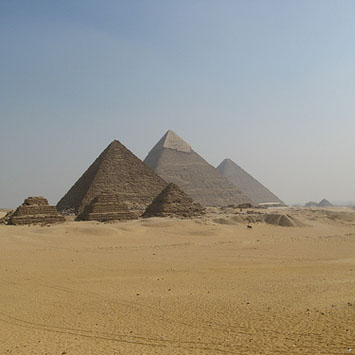Why Super-Cements May Hold Secrets of the Pyramid Builders Cement is quite literally the foundation on which modern civilization is built. It’s mankind’s most common building material, and has been a key component in most of the world’s construction projects for over a century. Its origins are certainly ancient, and stretch back at least far as the Romans, and probably older still. The Romans may have learned cement-making from the Greeks.
-
-
Toronto is a good place to be for Egyptian lovers this month. While the weather in Toronto isnt exactly like Cairo (snowfall is common during November), there is going to be lots of important Egyptian activities happening. First the big event King Tut is coming to town! The North American show, which made its last stop in Indianapolis, is opening at the Art Gallery of Ontario on November 24. Advance tickets are on sale now. The show is going to go beyond King Tuts tomb to explore Egypt as it was during the Amarna period. One of the most important…
-
, of Australian National University, has said that Andean coastal South American Pottery, possibly Incan, has been discovered on the Galapagos Islands. The islands arenearly 1,000kilometers off the coast of South America, and its been widely believed, until now, that the first people to reach the Galapagos were European explorers in 1535. Dr. Haberle, along with Professor Atholl Anderson, is leading a team of scientists who are looking for evidence that people voyaged on the Galapagos Islands before Europeans arrived in the 16th century. Theyve been re-analyzing all the pottery that has been discovered in the Galapagos Islands so far.…
-
Theyve faced bombs, the Taliban and civil war, and now Afghanistans ancient treasures have a new challenge a Canadian museum strike. This Friday, the exhibit, Afghanistan: Hidden Treasures from the National Museum, will be making its next stop in Ottawa Canada. As Heritage Keys Helen Atkinson writes, it features treasures from Afghanistans history that have survived the turmoil the country has faced for the past three decades. In Ottawa the Canadian Museum of Civilization, where it will be displayed, has been experiencing a strike by more than 400 of its workers, including guides and educational staff. They walked off the…
-
At the corner of Bloor and Queens Park a security guard uses a blow-horn to yell out a warning the line-up to see the Ten Commandments is very long and theres no guarantee you will get to see it. For those who dont have a membership at the Royal Ontario Museum, but want to see the commandments anyways, the line starts here, at this Toronto street intersection. Despite asizable lobby the museum simply isnt big enough to contain the people who want to buy a ticket this Saturday afternoon (Oct. 17). I get to skip this particular line since I…
-
Senwosret III probably isnt the first person you think of when it comes to the Nobel Prize, but this ancient Egyptian Pharoah was making a significant contribution to future archaeology long before Barack Obama stole the show by scooping this year’s Nobel Peace Prize. The Egyptian pharaoh, who lived ca. 1870-1831 BC, launched several military campaigns into Nubia. As Egyptologist Gae Callender writes in The Oxford History of Ancient Egypt these were brutal conquests. Nubian men were killed, their women and children enslaved, their fields burnt, and their wells poisoned. Not something Alfred Nobel would condone. Nevertheless, in an indirect…
-
For the last 12,000 years people have clustered near the Great Lakes, using them for drinking, food, sanitation and transportation, and the area is ripe for archaeological exploration. The shorelines of these lakes have have shrunk and expanded as the climate changed, which means that many ancient sites are now underwater. With advances in underwater archaeology now enabling more and more offshore excavations, this would not normally be a problem. However, in this case, it seems that archaeologists have turned up just a few decades too late. A recent massive invasion of zebra mussels is making progress extremely difficult. During…
-
Starting this Saturday, the second oldest copy of the Ten Commandments will go on display, at the Royal Ontario Museum, for 80 hours only. The exhibit will run from October 10 to October 18. It runs concurrently with a Dead Sea Scrolls exhibit that is taking place at the museum. The Israel Antiquities Authority has been very cautious about how much light it gets exposed to which is the reason why it is only going to be put on display for 80 hours. Damage due to light is accumulative and it just gets worse and worse, said Dan Rahimi, an…
-
The MilwaukeePublic Museum is going to be the site of a major Dead Sea Scrolls exhibition starting January 22, 2010. The exhibition will feature the recently discovered Jeselsohn Stone, which only came to light recently. The stone is estimated to be about 2,000 years old. It was acquired by a collector, David Jeselsohn, about 10 years ago. Where it was found is unknown, although Jordan has been suggested as a probable location. Its partially legible and, as such, onlychunks of the inscription can be made out. It appears to be written by someone named Gabriel (it has the words I…
-
There is some interesting news coming from Tayinat that Heritage Key will be reporting on soon as part of a larger article. Tayinat is the site in southeast Turkey that has been making media headlines for the discovery of a tablet cache. It wasfound in atemple that was reported, in many outlets, to have stood during the Dark Ages. I sat down with Professor Timothy Harrison, the project leader, to learn about what they found. News on the tablet discovery First bit of news, an update on the tablet cache discovered this summer. In 738 BC Tiglath Pilesar III destroyed…


